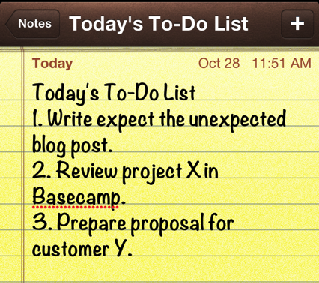 It’s important to leave slack in your schedule to allow for the unexpected, which really sort of means the unexpected is expected. I’m doing this by making shorter lists and it’s helping me to get more done. Lists are great but they can be overwhelming. Sure it makes sense to have a master list of all the things you need to get done someday, but working from a list that long can be challenging. Instead I’m talking about the list for today that starts with three – and only three tasks – to complete today.
It’s important to leave slack in your schedule to allow for the unexpected, which really sort of means the unexpected is expected. I’m doing this by making shorter lists and it’s helping me to get more done. Lists are great but they can be overwhelming. Sure it makes sense to have a master list of all the things you need to get done someday, but working from a list that long can be challenging. Instead I’m talking about the list for today that starts with three – and only three tasks – to complete today.
Plan for interruptions and course changes
If the list you are working from has 20 or 30 tasks to complete, how can you ever feel comfortable diverting from that list to take care of unexpected interruptions that could bring another task to the forefront? Maybe a client calls with an emergency that if you help them solve makes you that much more valuable to them. These types of interruptions happen each and every day and learning to expect them with a willingness to change course will help you treat the the interruptions as opportunities.
This new attitude starts by not planning to have too much to do on any given day. I’m working toward this goal by making sure my daily to-do list starts with only three items. I’ve tried this before and it worked so well that I’m not sure why I strayed from it.
Why starting with three items is the key
Three items, that’s it. First thing in the morning, write the three tasks that need to happen to push your business (or other life goals) forward. Typically these three tasks will be time sensitive and should be small enough that even with interruptions you can complete in one work day.
Throughout the day, it won’t be uncommon for two or three more tasks to be added to the list to address urgent customer or company needs. That’s why you only start with three to allow for the unexpected, which is really expected.
To-do lists in practice
In each of the business pursuits I participate in, we utilize Basecamp from 37signals as our project management or to-do list management system. It’s a great tool for managing and tracking multiple projects; each with multiple to-do lists and team members making the project move forward. However, it’s a horrible tool to manage your own time on a daily basis. Properly reviewing and organizing a single project can sometimes take hours. In other words, “review project X in Basecamp” is what one of my three daily to-do items often looks like. And at other times one of the Basecamp tasks assigned to me often becomes one of my three to-do items for the next day.
The plan each week is that I publish to this blog, the ColorMetrix blog, and our SheHe Media blog. That plan as you might imaging generates three of my 21 weekly daily to-do items. Thing about that number “21,” If you stick to this plan you will complete a minimum of 21 to-do tasks each week. This approach isn’t about getting everything done today. Instead it’s about breaking everything (even your largest tasks) down into manageable pieces that can be quickly completed allowing you to move on to yet another task.
If we assume an eight-hour work day, I like to say that only about 50 to 60 percent of your planned work hours should be consumed by the three tasks you choose each morning. This allows not only for those two or three inevitable interruptions, but also for extra time spent on your three chosen tasks.
So give this method a try and stop back with a comment about how it’s working out for you. Or just leave a comment now with what’s already working for you.